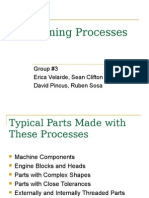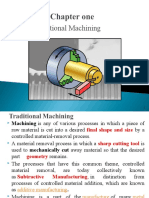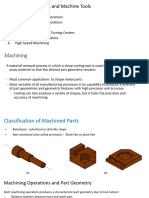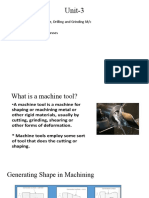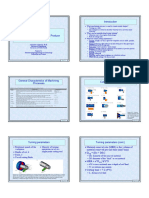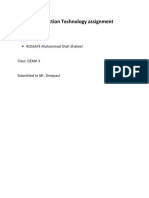0% found this document useful (0 votes)
22 views30 pagesManual of Machine Shop
The document outlines various machining operations performed on lathe, milling, drilling, and shaper machines, detailing their functions and the tools required for each process. It emphasizes the importance of these machines in producing precise components from materials like mild steel and wood. Additionally, it covers carpentry basics, including tools and types of timber used in woodworking projects.
Uploaded by
Mohammad El ahmadCopyright
© © All Rights Reserved
We take content rights seriously. If you suspect this is your content, claim it here.
Available Formats
Download as PDF or read online on Scribd
0% found this document useful (0 votes)
22 views30 pagesManual of Machine Shop
The document outlines various machining operations performed on lathe, milling, drilling, and shaper machines, detailing their functions and the tools required for each process. It emphasizes the importance of these machines in producing precise components from materials like mild steel and wood. Additionally, it covers carpentry basics, including tools and types of timber used in woodworking projects.
Uploaded by
Mohammad El ahmadCopyright
© © All Rights Reserved
We take content rights seriously. If you suspect this is your content, claim it here.
Available Formats
Download as PDF or read online on Scribd
/ 30
LATHE MACHIN
Experiment no: 02
ro study the various operations performed on Lathe Machine and prepare 2 Job On it.
Aim:
APPARATUS: lathe machine, mild steel rod and tools.
OBJECTIVE: To study the various operations such as turning. step turning, facing, boring, taper
turning, knurling, grooving, threading of center lathe. And
To make the part shown in the sketch from a mild steel rod on a Lathe
careovines ~
+ 2 ok. “yf |
THEORY: A product is made up of many components which are manufactured by various
manufacturing processes such as casting. forging. welding; machining ete depends on the
application and cost of that particular component. Inthe machining prowess various operations
comes like turing, step turning, facing, boring, taper turning, knurling, gro. Bs threading. All
these operations can be done on center lathe hence center lathe is one Of the importance type of
tnachines. In tis practical we are going to study the operations which are mentioned above. Lathe
jeamachine tool which rotates the work piece on its axis to perform various operations such as
uting, sanding, knurling, drilling or deformation with tools thay are applied to the work piece to
freate an object which has symmetry about an axis of rotation Examples of objects that can be
produced on a lathe include candlestick holders, gun barrels, sticks, table legs, bowls, baseball
fats, musical instruments (especially woodwind instruments), crankshafts and camshafts,
Parts of Jathe and their function:
‘Almost all lathes have a horizontal beam is ¢:
ting tail stock and carriage.
alled as bed. It has guide ways
‘At one end of the bed (almost always the left, as the
tains drive mechanism with necessary
It also has chuck whichis used to old the}
A. Saddle: Its base portion, located acr
: lathe bed and carries cross slide and tool post, it can
moved longitudinally along the bed.
B. Apron; it is attached to saddle and appears as hanging on front side, It consists of gears for
motion transmission.
C: Cross slide: it is mounted on top of the saddle and acts as support to compound rest
D: Compound rest: It is mounted on cross slide and it consists of swivel and top slide. The tool
post is mounted on top slide.
E: Tool-post: it is used to hold the tool position the tool as per the requirement
Bea
3 Jow Chuck
Headstock
Feed Gear Box
Cross Slide
Compound Sige
Saddie i
Forward Reverse
Fig: Schematic Illustration of center lathe
Various Lathe operations
Turning: Itis the process of removing the material from extended surface of rotating work piece.
So it is the process by which a piece
of material (wood, metal, plastic, or stone) is rotated and a
cutting too! is traversed along 2 axgs of motion to produce precise diameters and depths
Step Turning: It is the process of obtaining different diameters on a work piece along the length
by adjusting depth of the tool.
NORMAL LATHE AXIS SET OVER
WORKPIECE axis *
|_|
os
DIRECTION OF FEED,
PORTION REMOVED
Boring: It is the machining of internal eylindrical forms ( generating ) a) by mounting work
iar uncle via a chuck or faceplate b) by. mounting work piece onto the CREE eRe
placing cutting tool into the chuck.
Knurling: The cutting of a serrated pattern onto the surface of a part to use as
A hand grip using a
special purpose knurling tool
Threading: It is the process of producing the helical V grooves on the surfac
with the help of
lead screw.
DIRECTION Of TOOL TRAVEL =p
Grooving: It is the process of producing V shape cyclical groove on the surface, the tool has
similar V shape as required to produce on work piece
CONCLUSION: : ; f
‘We have studied various operations such as turning, step turning, facing, boring, taper turning,
Jnatling, grooving. and threading which are performed on center lathe, And With the belp of
Above mosedure, we have made the part of above sketch on lath from a mild steel rod
the various operations s
; uch on Milling
slot shown inthe sketch on the specimert n=” And To machine the
PLL DIM
a work part is fed past a rotating cylindrical tool
ing tool is perpendicular to the direction
ed direction is one of the features that
fed in a direction parallel to its axis
cer and the cutting edges are called
milling machine. The
a machining operation in which
ng edges. The axis of rotation of the cut
ation between the tool axis and the fe
illing, the cutting tool is
led a milling cutt
performs this operation is an
Other work geome! can be created either
to the variety of shapes possible and its high
machining operations.
from drilling. In dri
iting tool in milling is cal
tool that traditionally
d by milling is a plane surface
path or the cutter shape. Owing
ling is one of the most versatile and widely used
rations
fonst There are two basic types of milling OPS
on is performed by cutti
i 'Y cutting ed
| milling are shown in Figure
(b)
Slotting
Straddle
of the cutter is perpendicul:
ar to the surface bei mack
i ing milled, a i
eae on both the end and outside periphery of the cuter, a a el
s of face milling exist, several of which are shown in Figur ee
re
sh
Me
Lie
-
©) ry i
End Profile haste ]
miling ming mailing ety
da table for fast
as horizontal or vertical.
id this design is well-suited for
«d straddle milling) on work parts
st provide a rotating spindle for the cuter an
“the work part. Milling machines can be cl
g machine has a horizontal spindle, an
ing (e.g., slab milling, slotting. side
this orientation is appropriate for face
has a vertical spindle, and
relatively flat work parts.
e contouring, and die sinking 0”
Milling Cutters
: ‘
(A)Plain Milling Cutters 8 d :
2 i
(a) (b) © @
Light duty Light duty helical Heavy duty High helix
(B) Side milling cutter
(a) (b) ()
Plain Staggered tooth Half side
(©) Face and angular milling cutter
Face Milling Cutters
(D) High Speed Steel End Mills
(a) Singio-ens hoticat teeth ang mh f
ovens ani, Neca ENR en THE
x
(0) Forty five-decree els, angle clumnum cutting end axl
{6 Stragtt-tooth
fe) Rouglnng i
Conventional
ing and Climb milling
One final consideration Concerning feed is the direction in which the work is fed into the cutter. The
most commonly used method is to feed the work against the rotation direction of the cutter
(Conventional or up milling) (Figure-a). However, if the machine is equipped with a backlash
climinator, certain types of work can best be milled by climb milling. Climb milling, which can
increase cutter life up to 50 percent, is effective for most milling applications. To know whether
climb or conventional milling is being used, look at the relationship between the cutter rotation and
the direction of the machine table/work feed. Climb milling is being used when the cutter and the
work piece are going in the same direction (Figure-b). Conventional milling is when the cutter and
the work piece are going in opposite directions
Cuner rotation direction Cuma: rotation direction,
v
——> Feed direction
(a) Conventional miling (up milling) (8) Climb miting (down milling
RESULT: We have studied various operations on milling machine. And, we have
above sketch on milling machine from a mild steel rod. i
DRILLING MACHINE
Experiment nas a
Aim: To study the various operations performed on Drilling Machine and prepare a Job 0
APPARATUS: Drilling machine, mild steel plate and tools,
OBJECTIVE: To study the variow: i i i
Wego ce ious operations on drilling machines such as drilling. reaming. Spot
To drill ile, as shown in the sketch, ream and tap holes on the mild steel plate.
THEORY: Holes in the work piece are necessary for many purposes such as fastening the object
with nuts and bolts, Screws, for fixing assembly purpose so it is necessary to make holes in the
work piece, So the Drilling is a process of making a hole in the blank work piece, or enlarging the
existing hole. The Machine which is used for this purpose is called as drilling machine. It consist of
spindle which is rotated by the motor and transmitting mechanism, The spindle in tum rotates the
Gilling tool called as drill, as drill is press fitted into the spindle, Drill i fed into work by feed
mechanism. The work piece is fixed on the table, as the drill fed into the work piece; the hole is
‘created by removing material in the form of chips. All the components are supported by frame.
Cutting fluid is commonly used to cool the drill bit, increase tool life, inerease speeds and feeds,
increase the surface finish, and aid in ejecting chips:
Radial Arm Drill bea
Column ‘ - fe
a |.
y
San sIINPLe
SP cL NOSE
Parts of Drilling machine and their fun
Base: base is the lowest horizontal part which supports the entire structure of drilling
machine, It is made up of cast iron because
Nn cast iron absorbs vibrations. So the vibrations
transmitted to foundation get reduced. S
Work table: It is mounted on column which supports the work. Generally its has two types
of motions. A. It can swing about column, B. it can move up and down, This facilitates the
positioning of work piece while drilling.
Spindle: It is a hollow portion which is provided with rotary motion spindle imparts this
rotator motion to drill.
Head; It consist of drive mechanism and feed mechanism.
Operations Performed on the drilling machine
Drilling: It is the process of making a hole in blank work piece with tool known as drill,
‘ze se
aa
Boring: It is process of enlargi
ae Bing the already existing hole to meet the required Size and
Neresieon
Spot facing: It is the process of machining a flat circular surface around a hole to provide a
seat for a bolt head nut or washer.
ous Operations such as drilling,
n Drilling machine. And With th
mild-steel plate
Teaming, spot facing, counter boring which
¢ help of above Procedure, we have made the
Aim: To study the various operation: performed on Shaper Machine and prepare a J
APPARATUS:
haper machine and mild steel rod,
OBJECTIVE: To study the various operations such on shaper machine, And To machine a V-block
as shown in the sketch out of the work piece provided on a Shaper Machine.
~ THEORY: The shaper is a reciprocating type of machine tool intended primarily to produce flat
surfaces. These surfaces may be horizontal, vertical or inclined. In general, the shaper can produce
+ any surface composed of straight line elements. Modern shaper can generate contoured surface
= RAM: The ram is the reciprocating member of the shaper. This is semi-cylindrical in form
and heavily ribbed inside to make it more rigid. It slides on the accurately machined dovetail
guide-ways on the top of the column, It houses a screwed shaft for altering the position of the
tam with respect to the work and holds the tool head at the extreme forward end
TOOL HEAD: The tool head of a shaper holds the tool rigidly, provides vertical and angular
feed movement of the tool and allows the tool to have an automatic relief during its retum
= :
SHAPER MECHANISM: In a shaper. rotator movement of the drive is converte
movement by the mechanism contained within the column of the machine. The ram holdi
gets the reciprocating movement, In a standard shaper, metal is removed in the forws
stroke, while the return stroke goes idle and no metal is removed during this period. To ae
total machining tim necessary to reduce the time taken by the return stroke. Thus the shaper
mechanism should be so designed that it can allow the ram holding the tool to move at_
comparatively slower speed during the forward cutting stroke, the cutting speed depending upon the
type of material and machining condition, whereas during the return stroke it can allow the ram to
move at a faster rate to reduce the idle return time. This mechanism is known as quick return
mechanism.
Cutting Too! Too!
~ Return Stroke
(Gavan tone!
4 “Liss get e material required for the job.
-2.Now, with the | lp of -sure ma ran engthand > mm ea
KLU—
CARPENTRY
Introduction:
F Carpentry may be defined as the process of making wooden components. It deals
with the building work, furniture, cabinet making etc. Jointly, i.e., Preparation of joints is one of
the important operations in all wood works, It deals with making joints for a variety of applications
viz, door frames, window frames, wardrobes, cupboards, stairs etc. In this chapter tools and
works associated with joinery are presented.
‘ial — Timber:
Timber is the basic material used for any class of carpentry work. The term timber is applied
to the wood obtained from; well-grown trees. The trees are cut, sawn into various sizes to suit
the required purpose.
Common Varieties of Indian Timber:
Indian timbers most commonly used for various carpentry words are as follows: Babul, Deodar,
Mahogany, Mango, Sal, Sissy and teak.
arpentry Tools:
In carpentry large numbers of hand tools are used for processing the wood. Here, the details
of tools that are being used in our workshop only are presented
Marking and Measuring Tools:
Steel Rule: It is strip of steel with graduations on its edges and is used for measuring and
setting out dimensions
Try Square: Try squares are used for marking and testing of right angles and for testing
flatness of surface.
Marking Gauge: It is a tool which has one projected marking pin and is used to mark
accurate lines parallel to the true edge of a wooden piece.
Holding Tools:
Carpenter’s Vice: It is used for holding the work for planning, sawing and chiseling. The
whole vice is made of iron and steel. It has two jaws one of which is fixed to the side of the
table while the other is movable.
€-Clamp; It is used for holding the work projecting above the top surface of the Bench.
This is used to prevent the wood from moving forward when being planned.
Bench Stop: Itis simply a block of wood projecting above the top surface of the bench, This
'SUsed to prevent the wood from moving forward when being planed. a
KLU
a
Firmer Mortise
Chisel Chisel Wood rasprfile
i |
Pincer Claw Hemmer
SS | Morse ang tenon
Lap
Wood Joints
Wooden Jack Plane: It consists of wooden body in which blade is set at an angle of 45
degrees to the body or sole. The cutting blade used is made of high carbon steel and is very
similar to a chisel. Jack Plane is a general purpose plane and is used to produce flat and
smooth surfaces on wood.
Hand or Cross-cut Saw: It is used to cut across the grains of the stock or thick wood. The
teeth are set alternately to the right and left of the blade, and its purpose is to make the cut
wider than the thickness of the blade. This allows the blade to move freely in the cut, without
sticking. Her teeth are set at 2.5 mm apart.
Tenon Saw or Back Saw : This saw is mostly used for cross cutting when a finer and more
acourate finish is required. The teeth are shaped in the form of an equilateral triangle and
generally have 13 teeth for 25 mm length. -
Firmer Chisel or Straight Edge Chisel : It is a general-purpose chisel and is used for
cutting and shaping wood accurately. The width of the blade varies from 1.5 to 50 mm.
Adze: Adze is a side axe used to chop extra wood quickly by carpenters. Adze with very
long handle is used to plane long palm tree barks in standing position and also used as a
hammer.
Miscellaneous Tools:
Pincer: Itis made of steel with a hinged joint and is used for pulling out small nails from wood
Claw Hammer : Itis a dual-purpose hammer. It has a hammer face, which is used to drive in
nails and claw at the other end for pulling out mails from the wood.
Wood Rasp File: It is a finishing tool used to make the wood surface smooth, remove the
sharp edges and other interior, surfaces. Sharp cutting teeth are provided on its surface.
This file is exclusively used in woodwork. 7
lere are many kinds of joints used tc connect wood stock. Each joint has a definite use and
ired marking, cutting and joining together. The strength of the joint depénds on the amount
tact area. Ifa particular joint does not have much contact area, then it must be rei
, screws or dowels.
inforced
int: Also called halving joint. The aim of this joint is to secure the corners and
of the framing and at the same time in the same plane. They may be usefully
many types of framing where strength and appearance are of secondary
KL U—
All dimensions are in mm.
qi
— 7 LU
Mortis 8 ily of j
@ and Tenon Joint: This family of joints is a large one and does probably the wood
worker u: i
ise the commonest. It consists of a rectangular peg (tenon) fitting into a rectangular
hole (mortise).
Briddle Joint: These are the reverse of mortise and tenon joints in form arid are often called
the open mortise tenon. These joints are used where the members are of ‘square or near-
Sqliare or near-square section and thus unsuitable for making a mortise and tenon joint of
good proportions.
Instructions
A, When you are using your thumb as a guide for cross cutting and ripping, raise it
sufficiently high.
2. Planing should be done along grains only.
Push the chisel away from you while chiseling.
Always use marking gauge (or) a mortise gauge for drawing lines.
Check the squareness of planned surfaces with try square.
‘Use wooden mallets for driving chisel
not test sharpness of the edge of the cutting tools on your hand.
t keep your hands In front of the sharp edged tools while they are in use.
‘unwanted material should be removed.
4, MORTISE & TENON JOINT
KL U—
Safety Precautions :
General : Make sure that your hands are not in front of sharp edged tools while you are using
them.
Saws : Be careful when you are using your thumb as a guide in cross cutting
Chisels :
1. Never chisel towards any part of the body.
2. Test the sharpness of the Cutting edge on wood or paper, not on your hand.
Exercise:
1. Lap Tee Joint
2. Cross Lap Joint or Lap ‘+’ Joint
3. Dovetail Lap Joint
4. Mortise & Tenon Joint
KLU—
1, Lap Tee Joint
All di ions are il
ht
LAP TEE JOIN
Date:
pare a Lap Tee Joint as per dimensions given in sketch
quired: Teak wood 300mm X 45mm X 35mm
Steelrule 300mm
2. Handsaw~ 300mm
3. Wooden jack plane 450mm
4. Try square 200mm
5. Marking gauge 200mm.
6. C-Clamp 200mm
7. Firmer chisel 150mm
8. Adze 150mm
ice of Operations:
Marking 2. Planning 3.Cutting 4. Setting
re:
_ 1. Select a teak wood materia! and mark the size as per drawing with the help of
marking tools like steel rule, marking gauge, try square.
Planning of sides with the help of wooden jackplane to maintain the required
dimensions.
Fix the work piece in carpentry vice and cut into two equat pieces of size 150mm
10mm with the help of handsaw.
the two work pieces for male cutting and groove cutting as per dimensions.
work pieces one by one on the bench with the help of ‘C’ Clamp and a
is made as shown in drawing with the help of chisels and adze.
york pieces are fitted to make Lap Tee Joint as per drawing.
areful while marking and planning
uired while cutting the groove with firmer chisel so that the
ded.






